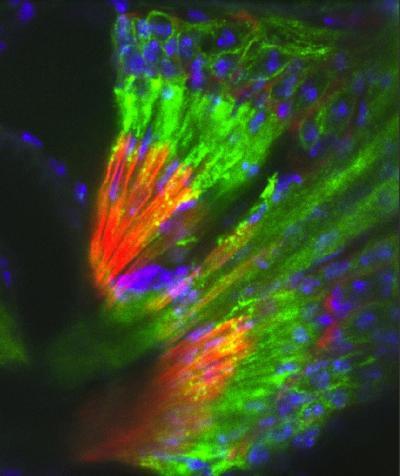One of the mechanisms involved in hearing is similar to the battery in your car. How do researchers know? They heard it in a fruit fly love song.
The auditory system of the fruit fly contains a protein that functions as a sodium/potassium pump, often called the sodium pump for short, and is highly expressed in a specialized support cell called the scolopale cell. The scolopale cell is important because it wraps around the sensory endings in the fly's ear and makes a tight extra-cellular cavity or compartment around them called the scolopale space.
"You could think of these compartments as similar to the compartments of a battery that need to be charged up so they can drive electrons through circuits," says University of Iowa biologist Daniel Eberl. "In the auditory system, the charge in the scolopale space drives ions, or electrically charged atoms, through membrane channels in the sensory endings that open briefly in response to activation by sounds. Our work shows that the sodium pump plays a particularly important role in this cell to help replenish or recharge this compartment with the right ions. The human ear also relies on a compartment called the scala media, which similarly drives ions into the sensory cells of the ear."
Located within the antenna of a fruit fly, the auditory organ (pictured) is shown being activated in response to the fruit fly love song. The sodium pump is stained in green, while blue highlights nuclei and red stains the cytoskeletal protein, actin. Image provided by Madhuparna Roy.
How was the research done? This is where the fruit fly love song comes into play.
Testing whether or not a fruit fly can hear the love song—a sound generated by a vibrating wing—enables Eberl to learn whether electrical recharging is occurring in the fly ear. The fruit fly love song played a role in the research by stimulating the fly to move whenever a sound was emitted and received. "In these experiments we tested the fly's hearing by inserting tiny electrodes in the fly's antenna, then measuring the electrical responses when we play back computer-generated love songs."
There are many similarities between fruit fly and human mechanisms of hearing. That means the work on the fly model to identify additional new components required for generating the correct ion balance in the ear will help scientists to understand the human process in more detail.
Eberl's co-authors on the paper are Madhuparna Roy, postdoctoral associate at the University of Pittsburgh, and Elena Sivan-Loukianova, UI biology research scientist. At the time of the research, Roy was a graduate student in the UI Graduate College studying in the College of Liberal Arts and Sciences Department of Biology.
Paper: "Cell-type-specific roles of Na+/K+ ATPase subunits in Drosophila auditory mechanosensation" was published in PNAS.






Comments